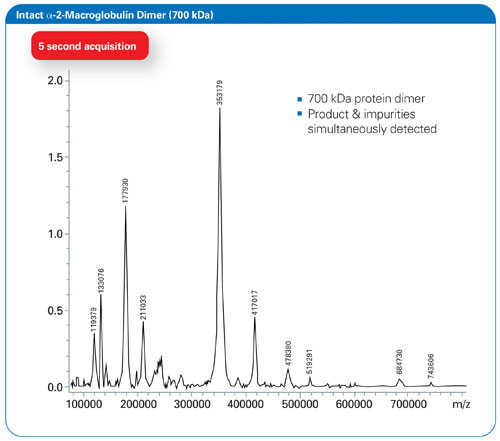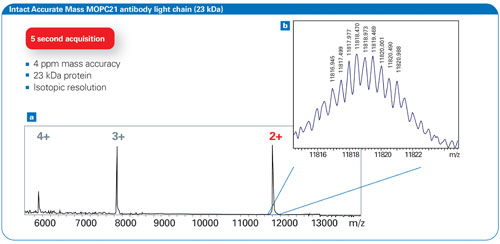June 15, 2013 (Vol. 33, No. 12)
Mass Spectrometry Provides Complete Characterization of Biopharmaceutical Products
Chemical analysis is a critical need in our high-tech industrial world. Mass spectrometry, with its high sensitivity and high selectivity, occupies a pivotal role in the detection and quantitation of a vast array of chemical substances. It is the approach of choice for the characterization of biopharmaceutical products and potential impurities, and allows for accurate product development, rapid regulatory approval, and expeditious entry into production.
Biopharmaceuticals generated through recombinant DNA technology are becoming more and more significant in the therapeutic landscape. Because they are synthesized by living cells, their production is profoundly affected by minor variations in culture conditions. Regulations demand precise monitoring of their constituent properties, and mass spectrometry is well-suited as the optimal analytical tool.
The term “analyze by mass spectrometry,” particularly when attached to a biopharmaceutical sample, does not reference a singular tool or technique but rather any number of a wide variety of mass analyzers and sampling techniques, each with unique characteristics, advantages, and disadvantages. For many mass spectrometry techniques, collection, separation, and preconcentration of the sample are necessary and often followed by derivatization of targeted compounds to optimize their chemical properties to enhance their measurement.
Mass spectrometry systems often combine two mass analyzers as combinations of different basic types. Their overall design can be highly versatile in terms of the ionization methods and the types of measurements they are programmed to perform. Often the total time needed for the mass analysis step is measured in seconds but the sample preparation and pretreatment steps can take hours to execute. It is here where MALDI-TOF analyses offer a considerable advantage owing to the relative simplicity of sample preparation and of the mass analyzer.
The Bruker Daltonics ultrafleXtreme™ is a MALDI-TOF/TOF mass spectrometer designed to address a wide range of analytical problems. With features such as panoramic PAN™ technology, which provides high resolving power across a wide mass range; the Flash Detector™, which enables fast response with minimal saturation; and the 2kHz smartbeam™ II laser ultrafleXtreme can be applied into a variety of research areas. These include proteomics research, quantitation, top-down sequencing, and MALDI imaging.
For peptide analysis the system can exceed 40,000 FWHM resolution with corresponding measurement accuracy of Figure 1). For all these experiments ultrafleXtreme provides improved data acquisition speeds, spatial resolution, and better mass accuracy than other MALDI-TOF systems.
An additional component that improves the speed and accuracy of the system is the self-cleaning Perpetual™ ion source. This push-button function works in minutes for all MALDI matrixes to provide maximum up-time.
The software accompanying the ultrafleXtreme was specifically designed to be method-driven but also allow flexibility for any novel experiments. It can be operated in high-throughput at up to 2,000 Hz in MS mode and up to 1,000 Hz in TOF/TOF mode. In addition, the optimized Smartbeam-II laser delivers constant high output energy, independent of the selected repetition frequency across long acquisition runs.

Figure 1. Analysis of a large protein, a-2-macroglobulin
Measurement of Intact Protein Mass
MALDI mass spectrometry has the ability to rapidly characterize a biotherapeutic production run and identify the presence of any impurities. One of the hallmarks of MALDI is that it mostly produces ions with a single charge, regardless of analyte size. Under typical conditions, larger proteins may represent a small percentage of +2 and +3 ions but the dominant ion peak is the +1 charge state. This can be both good and bad. It is an advantage in that it simplifies spectral interpretation, particularly for mixtures, but it’s also a negative feature in that the +1 ion of larger proteins are detected outside of the optimal resolution range of TOF systems.
For example, ultrafleXtreme offers better than unit resolution for proteins up to m/z 13,000, and the resolved isotopic envelope allows for higher measurement accuracy. For larger proteins it follows that higher measurement accuracy could be obtained if the population of higher charge states could be increased so that the m/z of detected ions are within the range where ultrafleXtreme offers highest resolving power.
A frequent choice of matrix material for analyzing glycoproteins and mixtures containing glycoproteins is 2′,4′-dihydroxyacetophenone (DHAP). This is one of a few matrix compounds that tend to produce an elevated abundance of higher charge states e.g., +3, +4, +5, for larger proteins. Although multiple peaks can complicate spectra, the highly charged protein ions are now detectable within the m/z range of optimal resolution and often can be isotopically resolved.
A typical example is the analysis of small proteins. In this case, the ultrafleXtreme established an accurate mass for antibody light chains, produced by the mouse myeloma cell line, MOPC21. The quality of the MALDI data was comparable to that generated by electrospray ionization (ESI), but with the notable advantage of a significantly shorter analysis time (Figure 2).
Using this approach the ultrafleXtreme can provide ppm accuracy for proteins up to 70 kDa and isotopic resolution for proteins up to 30 kDa.
Whereas the ultrafleXtreme system is ideal for this protocol, it should be noted that the application can be performed on all Bruker MALDI-TOF systems using smartbeam™ laser technology, PAN wide-range focusing, and Flash Detector.

Figure 2. (A) Reflector mode spectrum of the light chain of MOPC21 antibody acquired from 2′,4′-dihydroxy-acetophenone/diammonium hydrogencitrate (DHAP/DAHC) preparation. (B) Zoom-in on 2+ ion showing isotopic resolution of the 23 kDa protein.
Conclusions
Mass spectrometry is demonstrating its value in an ever-widening range of applications. The ultrafleXtreme system is ideal for many of these expanded uses. Not only is it fast, with its heightened accuracy and simplified sample preparation, it is ideal for labs doing large-scale pathology series or environmental analysis. This means that applications that previously would not have been economically viable are now within the limits of feasibility.
In addition, its simplicity of operation means that samples can be processed more rapidly and the learning curve for personnel can be telescoped. These properties make the technology especially appropriate for core facilities, where these attributes are notably in demand.
Shannon Cornett, Ph.D. ([email protected]), is applications development manager at Bruker Daltonics.


